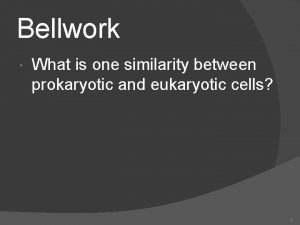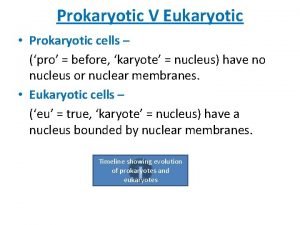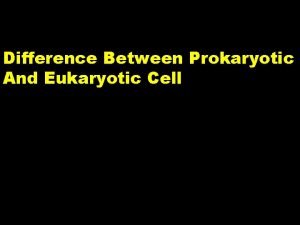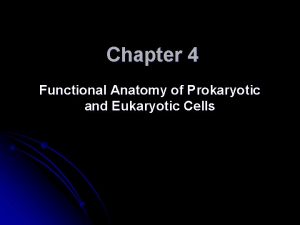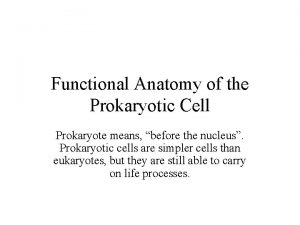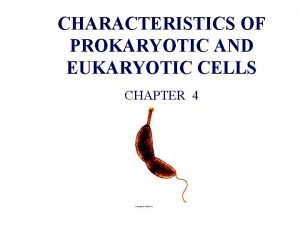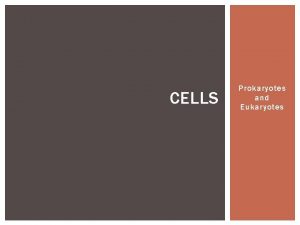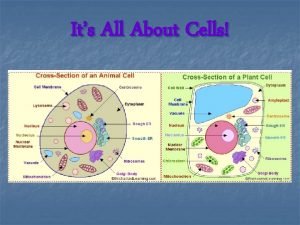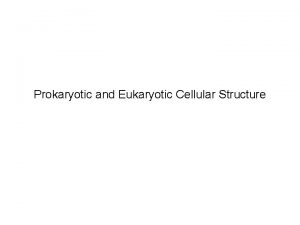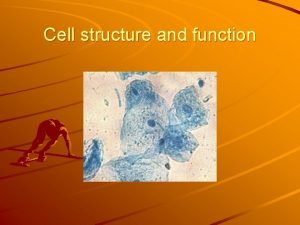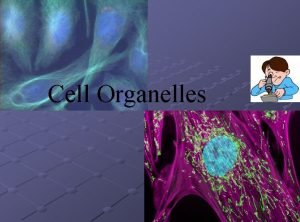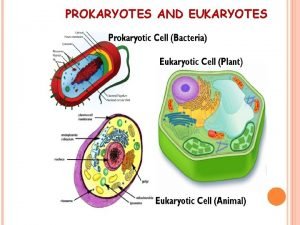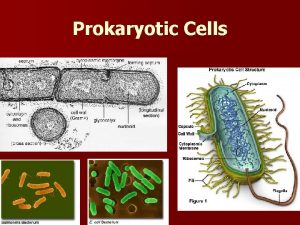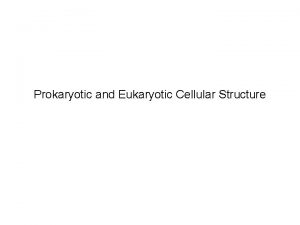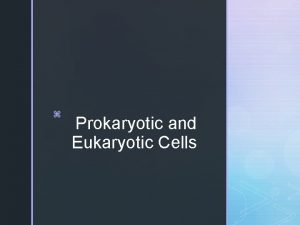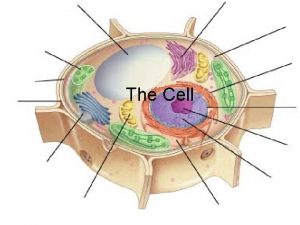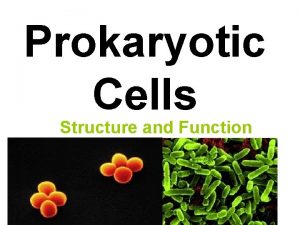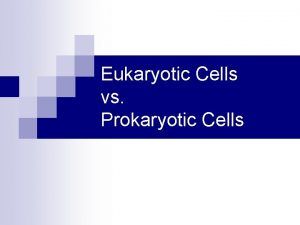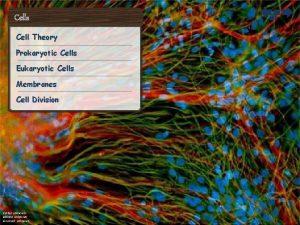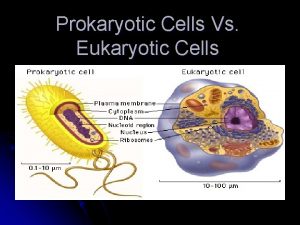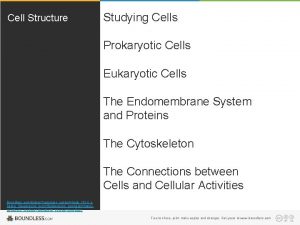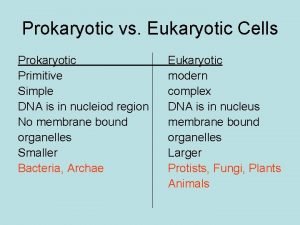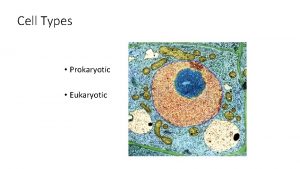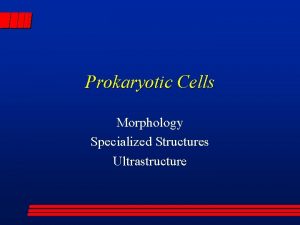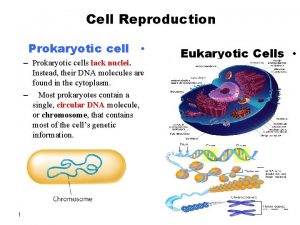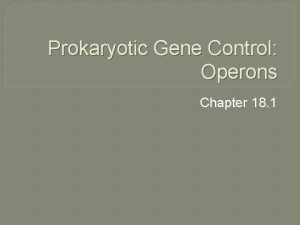Chapter 4 A Survey of Prokaryotic Cells and









































- Slides: 41

Chapter 4 A Survey of Prokaryotic Cells and Microorganisms Copyright © Mc. Graw-Hill Education. All rights reserved. No reproduction or distribution without the prior written consent of Mc. Graw-Hill Education.

Characteristics of Cells and Life All living things (single and multicellular) are made of cells that share some common characteristics: – Basic shape – spherical, cubical, cylindrical – Internal content – cytoplasm, surrounded by a membrane – DNA chromosome(s), ribosomes, metabolic capabilities Two basic cell types: eukaryotic and prokaryotic 2 Copyright © Mc. Graw-Hill Education. All rights reserved. No reproduction or distribution without the prior written consent of Mc. Graw-Hill Education.

Characteristics of Cells Eukaryotic cells: animals, plants, fungi, and protists – Contain membrane-bound organelles that compartmentalize the cytoplasm and perform specific functions – Contain double-membrane bound nucleus with DNA chromosomes Prokaryotic cells: bacteria and archaea – No nucleus or other membrane-bound organelles Copyright © The Mc. Graw-Hill Companies, Inc. Permission required for reproduction or display Prokaryotic Eukaryotic Chromosome Nucleus Mitochondria Ribosomes Cell wall Cell membrane Flagellum Cell membrane Copyright © Mc. Graw-Hill Education. All rights reserved. No reproduction or distribution without the prior written consent of Mc. Graw-Hill Education. 3

Eukaryotic cell Prokaryotic cell Copyright © Mc. Graw-Hill Education. All rights reserved. No reproduction or distribution without the prior written consent of Mc. Graw-Hill Education.

Copyright © Mc. Graw-Hill Education. All rights reserved. No reproduction or distribution without the prior written consent of Mc. Graw-Hill Education.

Characteristics of Life 1. 2. 3. 4. 5. 6. Reproduction and heredity – genome composed of DNA packed in chromosomes; produce offspring sexually or asexually Growth and development Metabolism – chemical and physical life processes Movement and/or irritability – respond to internal/external stimuli; selfpropulsion of many organisms Cell support, protection, and storage mechanisms – cell walls, vacuoles, granules and inclusions Transport of nutrients and waste 6 Copyright © Mc. Graw-Hill Education. All rights reserved. No reproduction or distribution without the prior written consent of Mc. Graw-Hill Education.

Structure of a bacterial cell 7 Copyright © Mc. Graw-Hill Education. All rights reserved. No reproduction or distribution without the prior written consent of Mc. Graw-Hill Education.

Flagellar Arrangements Monotrichous – single flagellum at one end Lophotrichous – small bunches emerging from the same site Amphitrichous – flagella at both ends of cell Peritrichous – flagella dispersed over surface of cell Copyright © Mc. Graw-Hill Education. All rights reserved. No reproduction or distribution without the prior written consent of Mc. Graw-Hill Education. 8

Flagellar Responses Guide bacteria in a direction in response to external stimulus: Chemical stimuli – chemotaxis; positive and negative Light stimuli – phototaxis Signal sets flagella into motion clockwise or counterclockwise: Counterclockwise – results in smooth linear direction – run Clockwise – tumbles 9 Copyright © Mc. Graw-Hill Education. All rights reserved. No reproduction or distribution without the prior written consent of Mc. Graw-Hill Education.

Fimbriae • Fine, proteinaceous, hairlike bristles emerging from the cell surface • Function in adhesion to other cells and surfaces 10 Copyright © Mc. Graw-Hill Education. All rights reserved. No reproduction or distribution without the prior written consent of Mc. Graw-Hill Education.

Pili • Rigid tubular structure made of pilin protein • Found only in gram-negative cells • Function to join bacterial cells for partial DNA transfer called conjugation 11 Copyright © Mc. Graw-Hill Education. All rights reserved. No reproduction or distribution without the prior written consent of Mc. Graw-Hill Education.

12 Copyright © Mc. Graw-Hill Education. All rights reserved. No reproduction or distribution without the prior written consent of Mc. Graw-Hill Education.

Glycocalyx • • Coating of molecules external to the cell wall, made of sugars and/or proteins Two types: 1. Slime layer - loosely organized and attached 2. Capsule - highly organized, tightly attached 13 Copyright © Mc. Graw-Hill Education. All rights reserved. No reproduction or distribution without the prior written consent of Mc. Graw-Hill Education.

Functions of the Glycocalyx • • • Protect cells from dehydration and nutrient loss Inhibit killing by white blood cells by phagocytosis, contributing to pathogenicity Attachment - formation of biofilms 14 Copyright © Mc. Graw-Hill Education. All rights reserved. No reproduction or distribution without the prior written consent of Mc. Graw-Hill Education.

Biofilm on a catheter 15 Copyright © Mc. Graw-Hill Education. All rights reserved. No reproduction or distribution without the prior written consent of Mc. Graw-Hill Education.

The Cell Envelope • External covering outside the cytoplasm • Composed of two basic layers: – Cell wall and cell membrane • Maintains cell integrity • Two different groups of bacteria demonstrated by Gram stain: – Gram-positive bacteria: thick cell wall composed primarily of peptidoglycan and cell membrane – Gram-negative bacteria: outer cell membrane, thin peptidoglycan layer, and cell membrane 16 Copyright © Mc. Graw-Hill Education. All rights reserved. No reproduction or distribution without the prior written consent of Mc. Graw-Hill Education.

Structure of Cell Walls • Determines cell shape, prevents lysis due to changing osmotic pressures • Peptidoglycan is the primary component: – Unique macromolecule composed of a repeating framework of long glycan chains cross-linked by short peptide fragments 17 Copyright © Mc. Graw-Hill Education. All rights reserved. No reproduction or distribution without the prior written consent of Mc. Graw-Hill Education.

Gram-Positive Cell Wall – 20 -80 nm thick peptidoglycan – Includes teichoic acid and lipoteichoic acid: function in cell wall maintenance and enlargement during cell division; move cations across the cell envelope; stimulate a specific immune response – Some cells have a periplasmic space, between the cell membrane and cell wall 18 Copyright © Mc. Graw-Hill Education. All rights reserved. No reproduction or distribution without the prior written consent of Mc. Graw-Hill Education.

Gram-Negative Cell Wall – Inner and outer membranes and periplasmic space between them contains a thin peptidoglycan layer – Outer membrane contains lipopolysaccharides (LPS) • Lipid portion (endotoxin) may become toxic when released during infections • May function as receptors and blocking immune response • Contain porin proteins in upper layer – regulate molecules entering and leaving cell 19 Copyright © Mc. Graw-Hill Education. All rights reserved. No reproduction or distribution without the prior written consent of Mc. Graw-Hill Education.

Structures of Gram-Positive and Gram-Negative Bacterial Cell Walls 20 Copyright © Mc. Graw-Hill Education. All rights reserved. No reproduction or distribution without the prior written consent of Mc. Graw-Hill Education.

Comparison of Gram-Positive and Gram-Negative Cell Walls 21 Copyright © Mc. Graw-Hill Education. All rights reserved. No reproduction or distribution without the prior written consent of Mc. Graw-Hill Education.

Concept Check: Which of the following is NOT found in the Gram. Negative cell wall structure? A. Porins B. Teichoic Acids C. Periplasmic Space D. Lipopolysaccharides E. Peptidoglycan 22 Copyright © Mc. Graw-Hill Education. All rights reserved. No reproduction or distribution without the prior written consent of Mc. Graw-Hill Education.

Concept Check: Which of the following is NOT found in the Gram. Negative cell wall structure? A. Porins B. Teichoic Acids C. Periplasmic Space D. Lipopolysaccharides E. Peptidoglycan 23 Copyright © Mc. Graw-Hill Education. All rights reserved. No reproduction or distribution without the prior written consent of Mc. Graw-Hill Education.

The Gram Stain • Differential stain that distinguishes cells with a grampositive cell wall from those with a gram-negative cell wall – Gram-positive - retain crystal violet and stain purple – Gram-negative - lose crystal violet and stain red from safranin counterstain • Important basis of bacterial classification and identification • Practical aid in diagnosing infection and guiding drug treatment 24 Copyright © Mc. Graw-Hill Education. All rights reserved. No reproduction or distribution without the prior written consent of Mc. Graw-Hill Education.

The Gram Stain Copyright © Mc. Graw-Hill Education. Permission required for reproduction or display. Microscopic Appearance of Cell Step 1 Crystal Violet (primary dye) 2 Gram’ siodine (mordant) Gram (+) Gram (–) Chemical Reaction in Cell (very magnified view) Gram (+) Gram (–) Both cell walls stain with the dye. Dye crystals trapped in cell No effect of iodine 3 Alcohol (decolorizer) 4 Safranin (red dye counterstain) Crystals remain in cell. Outer wall is weakened; cell loses dye. Red dye has no effect. Red dye stains the colorless cell. 25 Copyright © Mc. Graw-Hill Education. All rights reserved. No reproduction or distribution without the prior written consent of Mc. Graw-Hill Education.

Nontypical Cell Walls • Some bacterial groups lack typical cell wall structure, i. e. , Mycobacterium and Nocardia – Gram-positive cell wall structure with lipid mycolic acid (cord factor) • Pathogenicity and high degree of resistance to certain chemicals and dyes • Basis for acid-fast stain used for diagnosis of infections caused by these microorganisms • Some have no cell wall, i. e. , Mycoplasma – Cell wall is stabilized by sterols – Pleomorphic 26 Copyright © Mc. Graw-Hill Education. All rights reserved. No reproduction or distribution without the prior written consent of Mc. Graw-Hill Education.

Cell Membrane Structure • Phospholipid bilayer with embedded proteins – fluid mosaic model • Functions in: – Providing site for energy reactions, nutrient processing, and synthesis – Passage of nutrients into the cell and discharge of wastes – Cell membrane is selectively permeable 27 Copyright © Mc. Graw-Hill Education. All rights reserved. No reproduction or distribution without the prior written consent of Mc. Graw-Hill Education.

Nucleoid • Chromosome – Single, circular, doublestranded DNA molecule that contains all the genetic information required by a cell • Plasmids – Free small circular, doublestranded DNA – Not essential to bacterial growth and metabolism – Used in genetic engineering readily manipulated and transferred from cell to cell 28 Copyright © Mc. Graw-Hill Education. All rights reserved. No reproduction or distribution without the prior written consent of Mc. Graw-Hill Education.

Bacterial Ribosome • Ribosomes – Made of 60% ribosomal RNA and 40% protein – Consist of two subunits: large and small – Prokaryotic differ from eukaryotic ribosomes in size and number of proteins – Site of protein synthesis – Found in all cells 29 Copyright © Mc. Graw-Hill Education. All rights reserved. No reproduction or distribution without the prior written consent of Mc. Graw-Hill Education.

Bacterial Internal Structures • Inclusions and granules – Intracellular storage bodies – Vary in size, number, and content – Bacterial cell can use them when environmental sources are depleted 30 Copyright © Mc. Graw-Hill Education. All rights reserved. No reproduction or distribution without the prior written consent of Mc. Graw-Hill Education.

Bacterial Internal Structures • Cytoskeleton – Many bacteria possess an internal network of protein polymers that is closely associated with the cell wall 31 Copyright © Mc. Graw-Hill Education. All rights reserved. No reproduction or distribution without the prior written consent of Mc. Graw-Hill Education.

Bacterial Internal Structures • Endospores – Inert, resting, cells produced by some G+ genera: Clostridium, Bacillus, and Sporosarcina • Have a 2 -phase life cycle: – Vegetative cell – metabolically active and growing – Endospore – when exposed to adverse environmental conditions; capable of high resistance and very longterm survival – Sporulation - formation of endospores • Hardiest of all life forms • Withstands extremes in heat, drying, freezing, radiation, and chemicals • Not a means of reproduction – Germination - return to vegetative growth 32 Copyright © Mc. Graw-Hill Education. All rights reserved. No reproduction or distribution without the prior written consent of Mc. Graw-Hill Education.

Sporulation cycle 33 Copyright © Mc. Graw-Hill Education. All rights reserved. No reproduction or distribution without the prior written consent of Mc. Graw-Hill Education.

34 Copyright © Mc. Graw-Hill Education. All rights reserved. No reproduction or distribution without the prior written consent of Mc. Graw-Hill Education.

Endospores • • • Dehydrated, metabolically inactive Thick coat Longevity verges on immortality, 250 million years Resistant to ordinary cleaning methods and boiling Pressurized steam at 120 o. C for 20 -30 minutes will destroy 35 Copyright © Mc. Graw-Hill Education. All rights reserved. No reproduction or distribution without the prior written consent of Mc. Graw-Hill Education.

Bacterial Shapes, Arrangements, and Sizes • Vary in shape, size, and arrangement but typically described by one of three basic shapes: – Coccus – spherical – Bacillus – rod • Coccobacillus – very short and plump • Vibrio – gently curved – Spirillum – helical, comma, twisted rod, • Spirochete – spring-like 36 Copyright © Mc. Graw-Hill Education. All rights reserved. No reproduction or distribution without the prior written consent of Mc. Graw-Hill Education.

Common bacterial shapes 37 Copyright © Mc. Graw-Hill Education. All rights reserved. No reproduction or distribution without the prior written consent of Mc. Graw-Hill Education.

Pleomorphism • Variation in cell shape and size within a single species • Some species are noted for their pleomorphism 38 Copyright © Mc. Graw-Hill Education. All rights reserved. No reproduction or distribution without the prior written consent of Mc. Graw-Hill Education.

Bacterial Arrangements • Arrangement of cells is dependent on pattern of division and how cells remain attached after division: – Cocci: • • • Singles Diplococci – in pairs Tetrads – groups of four Irregular clusters Chains Cubical packets (sarcina) – Bacilli: • Diplobacilli • Chains • Palisades 39 Copyright © Mc. Graw-Hill Education. All rights reserved. No reproduction or distribution without the prior written consent of Mc. Graw-Hill Education.

Major Taxonomic Groups of Prokaryotes • Domain Archaea – primitive, adapted to extreme habitats and modes of nutrition • Domain Bacteria: – Phylum Proteobacteria – Gram-negative cell walls – Phylum Firmicutes – mainly Gram-positive with low G + C content – Phylum Actinobacteria – Gram-positive with high G + C content 40 Copyright © Mc. Graw-Hill Education. All rights reserved. No reproduction or distribution without the prior written consent of Mc. Graw-Hill Education.

Universal phylogenetic tree 41 Copyright © Mc. Graw-Hill Education. All rights reserved. No reproduction or distribution without the prior written consent of Mc. Graw-Hill Education.
 Eukaryotic life
Eukaryotic life Prokaryotic vs eukaryotic cells venn diagram
Prokaryotic vs eukaryotic cells venn diagram What animals have prokaryotic cells
What animals have prokaryotic cells Prokaryotic cell wall
Prokaryotic cell wall 3 parts of cell theory
3 parts of cell theory Differences between prokaryotic and eukaryotic cells
Differences between prokaryotic and eukaryotic cells Similarity between prokaryotic and eukaryotic cells
Similarity between prokaryotic and eukaryotic cells Answers
Answers Prokaryotic and eukaryotic cells chart
Prokaryotic and eukaryotic cells chart Difference between prokaryotic and eukaryotic
Difference between prokaryotic and eukaryotic Similarities between prokaryotic and eukaryotic cells
Similarities between prokaryotic and eukaryotic cells Differences between prokaryotic and eukaryotic cells
Differences between prokaryotic and eukaryotic cells Prokaryotic
Prokaryotic Functional anatomy of prokaryotic and eukaryotic cells
Functional anatomy of prokaryotic and eukaryotic cells What time did you arrive in class today
What time did you arrive in class today Characteristics
Characteristics Characteristics of prokaryotic cells
Characteristics of prokaryotic cells Prokaryotic cell domains
Prokaryotic cell domains Are prokaryotic cells living or nonliving
Are prokaryotic cells living or nonliving Prokaryotic cells
Prokaryotic cells Are cell walls prokaryotic or eukaryotic
Are cell walls prokaryotic or eukaryotic Prokaryotic cells lack
Prokaryotic cells lack Chapter 8 cellular reproduction cells from cells
Chapter 8 cellular reproduction cells from cells Onodi cells
Onodi cells Red blood cells and white blood cells difference
Red blood cells and white blood cells difference Plant and animal cells venn diagram
Plant and animal cells venn diagram Masses of cells form and steal nutrients from healthy cells
Masses of cells form and steal nutrients from healthy cells Tubular secretion
Tubular secretion Pineal gland
Pineal gland Gametic cells vs somatic cells
Gametic cells vs somatic cells Somatic vs germ cells
Somatic vs germ cells Organelle trail
Organelle trail Label
Label Cell substance
Cell substance 叫叫abcd
叫叫abcd Eukaryotes vs prokaryotes
Eukaryotes vs prokaryotes Venn diagram of plants and animals
Venn diagram of plants and animals Cytoskeleton prokaryotic or eukaryotic
Cytoskeleton prokaryotic or eukaryotic The oldest prokaryote is/are:
The oldest prokaryote is/are: Life
Life The 4 tissues
The 4 tissues Body tissues chapter 3 cells and tissues
Body tissues chapter 3 cells and tissues






